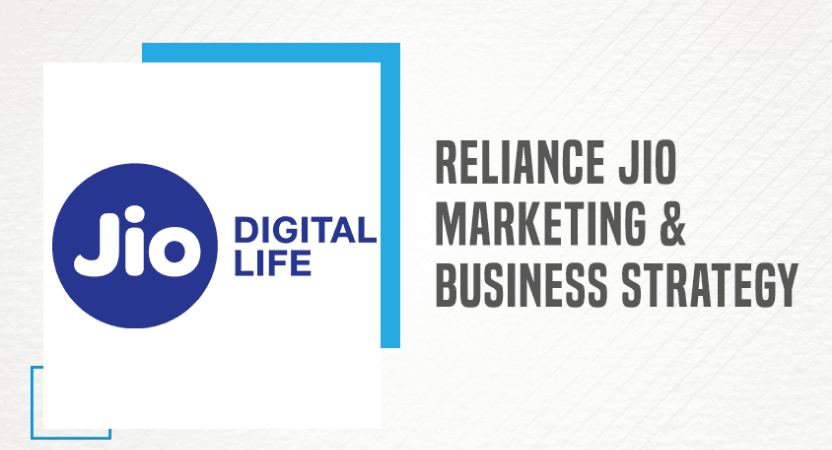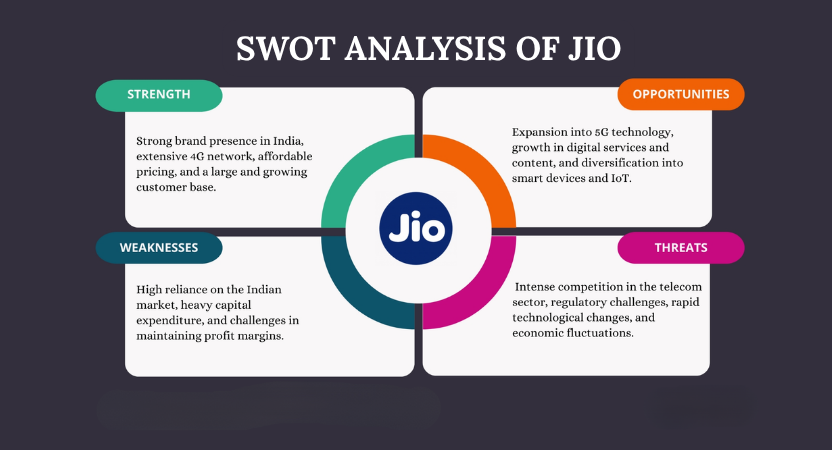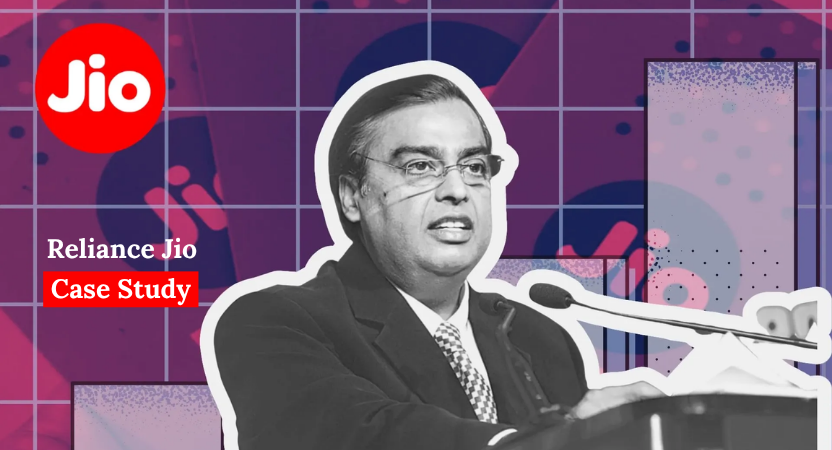Reliance Jio Infocomm Limited, widely known as Reliance Jio, is a telecommunications giant in India and a wholly owned subsidiary of Reliance Industries Limited (RIL), led by Mukesh Ambani. Since its commercial launch in September 2016, Jio has not just entered the Indian telecom market, it has completely transformed it. Within a few short years, Jio became India’s largest mobile network operator and one of the largest globally, achieving what most telecom companies could only dream of.
Before Jio’s entry, India’s telecom industry was dominated by players like Bharti Airtel, Vodafone, and Idea. Data prices were high, call charges were significant for many users, and 4G connectivity was limited to urban centers. Internet penetration, especially in semi-urban and rural India, remained relatively low due to affordability and infrastructural constraints. The country was still figuring out how to make digital connectivity more inclusive and accessible.
Then came Jio, with a mission to democratize data access and accelerate India’s transition to a Digital Bharat.
What set Jio apart was its bold market entry strategy. Jio launched 4G LTE services nationwide with an introductory offer that stunned the market: free voice calls, free unlimited data, and no roaming charges across India for several months. This not only disrupted existing telecom pricing models but also forced every other major operator to reassess their business and tariff structures. Within the first 83 days, Jio had acquired over 50 million subscribers. By the end of its first year, it crossed the 130-million-user mark, an unprecedented feat in the history of global telecommunications.
However, Jio’s ambitions extended beyond just being another telecom player. It envisioned building a complete digital ecosystem—a platform that would offer not just connectivity, but also content, commerce, cloud solutions, and devices. It launched its own suite of applications, including JioTV, JioCinema, JioSaavn, JioNews, and JioCloud, among others, which were bundled free with data plans. This move was not just to increase usage but to create stickiness—a reason for users to stay within Jio’s digital universe.
Jio also revolutionized hardware access. Recognizing that a large portion of India’s population still used feature phones, it introduced the JioPhone, a low-cost, 4 G-enabled device available at a refundable deposit. This allowed even the lowest-income households to access the internet, use apps, and consume content.
Its impact on the Indian economy and society has been profound. Jio’s affordable data prices significantly boosted internet adoption, social media usage, mobile commerce, and the gig economy. It empowered millions of students, small businesses, content creators, and freelancers by giving them the tools to go digital.
The company’s innovative and aggressive marketing, large-scale infrastructure investment, customer-centric pricing, and focus on digital inclusivity have made Jio not just a telecom company but a catalyst in India’s digital revolution.
This case study explores the core strategies that fueled Jio’s meteoric rise, its marketing brilliance, pricing tactics, product integration, strategic partnerships, and relentless push toward innovation and digital empowerment.
Let’s read the case study and understand Jio’s marketing and business strategies that have propelled it to the forefront of the industry.
1.Market Entry and Disruption

Reliance Jio’s entry into the Indian telecommunications market in 2016 marked a significant turning point. Before Jio’s launch, the market was dominated by a few key players, and data services were relatively expensive, limiting internet access for a large portion of the population.
Free Services at Launch:
Jio’s initial strategy was unprecedented. Under the “Welcome Offer,” later extended as the “Happy New Year Offer,” Jio provided free voice calls, SMS, and unlimited data. This aggressive approach led to rapid customer acquisition, with Jio amassing over 100 million subscribers within 170 days of launch. The offer disrupted the existing market dynamics, forcing competitors to reevaluate their pricing strategies.
Affordable Data Plans:
After the promotional period, Jio introduced competitively priced data plans that significantly undercut existing market rates. This move initiated a data price war, compelling other telecom operators to lower their tariffs. The result was a substantial increase in data consumption across the country, democratizing internet access and fostering a digital revolution.
Jio’s market entry strategy not only disrupted the telecom sector but also set new benchmarks for customer acquisition and service affordability. The company’s focus on providing high-quality services at low costs resonated with consumers, leading to a rapid expansion of its user base and setting the stage for further innovations in the industry.
2.Infrastructure and Technological Advancements
Reliance Jio’s commitment to building a robust and advanced telecommunications infrastructure has been central to its success.
Pan-India 4G Network:
Jio invested heavily in establishing a nationwide 4G LTE network from scratch. This extensive infrastructure ensured high-speed internet access across both urban and rural areas, laying the foundation for its vast subscriber base. The network’s reliability and speed attracted users seeking better connectivity.
5G Deployment:
In October 2022, Jio launched its 5G services in major cities like Delhi, Mumbai, Kolkata, and Chennai. By April 2023, the service expanded to over 2,500 cities, showcasing Jio’s commitment to technological advancement. The rapid deployment of 5G positioned Jio as a leader in next-generation connectivity, catering to the growing demand for faster and more reliable internet services.
Partnerships for Expansion:
Collaborations with global tech giants like Nokia, Ericsson, and Samsung facilitated the deployment of advanced network equipment, enhancing service quality and coverage. These partnerships enabled Jio to leverage cutting-edge technologies and expertise, ensuring the continuous improvement of its network infrastructure.
Jio’s focus on infrastructure development and technological innovation has not only improved service quality but also positioned the company at the forefront of the telecom industry’s evolution.
3.Digital Ecosystem Development
Beyond telecommunications, Reliance Jio has strategically developed a comprehensive digital ecosystem to cater to various consumer needs.
Jio Platforms:
Jio’s suite of digital services includes:
- JioCinema: An OTT platform offering a vast library of movies and TV shows, including exclusive content. In 2023, JioCinema set a global record with 32 million concurrent viewers during the IPL final.
- JioSaavn: A music streaming service boasting over 80 million tracks in multiple languages, catering to diverse Indian audiences.
- JioMart: An e-commerce platform integrated with WhatsApp, allowing users to shop directly through the messaging app. By 2024, JioMart expanded to 200 cities, challenging established players like Amazon and Flipkart.
Integration Strategy:
By bundling these services with its telecom offerings, Jio created a comprehensive digital ecosystem, enhancing customer retention and cross-platform engagement. This integration strategy not only provided added value to customers but also diversified Jio’s revenue streams.
Jio’s digital ecosystem development reflects its vision of becoming a one-stop solution for various digital needs, reinforcing its position as a technology-driven conglomerate.
4.Rural Penetration and Inclusivity
Recognizing the vast potential of rural markets, Reliance Jio implemented strategies to ensure digital inclusivity.
Affordable Devices:
To address the price sensitivity of rural consumers, Jio introduced LYF smartphones and the JioPhone at subsidized rates, making internet access more affordable. These devices enabled users in remote areas to connect to the internet, bridging the digital divide.
Localized Content:
Jio tailored its content offerings to regional languages and preferences, ensuring relevance and appeal across diverse demographics. By providing content in multiple languages, Jio enhanced user engagement and satisfaction among rural populations.
Educational Initiatives:
Through platforms like JioMeet and JioHealth, Jio provided access to online education and telemedicine services, addressing critical needs in underserved areas. These initiatives not only improved the quality of life in rural regions but also demonstrated Jio’s commitment to social responsibility.
Jio’s focus on rural penetration and inclusivity has significantly contributed to India’s digital transformation, empowering communities and fostering economic development.
5.Strategic Partnerships and Investments
Strategic collaborations and investments have played a crucial role in Reliance Jio’s growth and diversification.
Global Investments:
In 2020, Jio Platforms attracted significant investments from global entities, including Facebook, Google, and private equity firms, raising over $20 billion. These investments not only provided capital but also strategic partnerships to enhance Jio’s offerings. For instance, the collaboration with Facebook facilitated the integration of JioMart with WhatsApp, streamlining e-commerce operations.
Collaborations for Innovation:
Partnerships with companies like SpaceX aim to introduce satellite-based internet services in India, further expanding Jio’s reach and technological capabilities. These collaborations underscore Jio’s commitment to innovation and its ambition to provide cutting-edge services to a broader audience.
By leveraging strategic partnerships and investments, Jio has accelerated its growth trajectory and solidified its position as a global technology leader.
6.Marketing and Branding Strategies

Reliance Jio’s marketing and branding strategies have been instrumental in building a strong brand identity and customer base.
Celebrity Endorsements:
Jio leveraged Bollywood celebrities and sports personalities in its advertising campaigns, enhancing brand visibility and appeal. These endorsements helped Jio connect with a wide audience, fostering brand recognition and trust.
Massive Advertising Campaigns:
Utilizing television, print, and digital media, Jio’s marketing campaigns emphasized its value proposition, network quality, and digital services. The consistent messaging across various platforms reinforced Jio’s brand image as a provider of affordable and high-quality services.
Customer-Centric Approach:
Jio’s focus on customer satisfaction, through responsive customer service and continuous service improvements, fostered brand loyalty. By prioritizing customer needs and feedback, Jio cultivated a positive brand reputation and encouraged word-of-mouth promotion.
Jio’s comprehensive marketing and branding strategies have effectively communicated its offerings and values, contributing to its rapid market penetration and customer retention.
7.Financial Performance and IPO Plans
Reliance Jio’s financial performance reflects its successful business strategies and market dominance.
Subscriber Growth:
As of March 2025, Jio boasts over 479 million subscribers, making it India’s largest telecom operator. The continuous growth in the subscriber base indicates Jio’s strong market presence and customer appeal.
Revenue Growth:
Analysts project strong revenue and operating income growth for Jio, driven by continued user additions, potential tariff hikes, and expansion in home broadband services. The company’s diversified offerings and strategic pricing have contributed to its robust financial performance.
IPO Plans:
Reliance Industries plans to list Jio on the Mumbai stock exchange in 2025, potentially marking India’s largest IPO, with a valuation exceeding $100 billion. The IPO is expected to provide Jio with additional capital to invest in infrastructure and innovation, further strengthening its market position.
Jio’s impressive financial metrics and strategic plans underscore its status as a formidable player in the global telecommunications industry.
Also Read :- Zomato Case Study
SWOT Analysis of Reliance Jio (2025)

Strengths
- Strong Backing by Reliance Industries Limited (RIL):
With the financial muscle of one of India’s largest conglomerates, Jio benefits from immense capital support and strategic leadership under Mukesh Ambani. - Massive Subscriber Base:
As of 2025, Jio has over 479 million subscribers, making it the largest telecom operator in India. This scale gives it a strong market presence and network effect. - Affordable Pricing Model:
Jio revolutionized data consumption by offering low-cost data plans and free voice calls, setting industry benchmarks and expanding India’s digital user base. - Robust Infrastructure:
With pan-India 4G coverage and aggressive 5G rollout (over 2,500 cities by 2023), Jio has a modern and extensive network infrastructure. - Integrated Digital Ecosystem:
Services like JioCinema, JioSaavn, JioMart, and JioCloud enhance user retention and create a seamless ecosystem of telecom + digital services. - Global Strategic Partnerships:
Investments from Facebook, Google, Silver Lake, and others have not only infused capital but have also brought in cutting-edge technologies and platforms.
Weaknesses
- High Capital Expenditure:
Continuous investment in infrastructure (4G, 5G, fiber, and digital platforms) can strain financials if ARPU (Average Revenue Per User) does not rise proportionately. - Customer Service Concerns:
Rapid growth has sometimes outpaced service quality. Customer complaints regarding network congestion, data speed, and support are not uncommon. - Dependence on the Indian Market:
Despite size and dominance, Jio’s revenue is heavily dependent on the Indian market, making it vulnerable to domestic regulatory and economic changes. - Low ARPU Compared to Global Peers:
Despite a huge user base, the low average revenue per user limits profitability when compared with global telecom operators.
Opportunities
- Expansion into Rural and Tier 2/3 Cities:
With affordable phones like JioPhone and low data rates, Jio can further penetrate underserved regions, increasing digital inclusion. - IPO and Global Expansion:
The proposed 2025 IPO (potentially valuing Jio over $100 billion) will unlock fresh capital for expansion and diversification, including potential global ventures. - 5G Monetization:
Offering ultra-high-speed data, IoT solutions, AR/VR services, and cloud computing for businesses opens new high-value revenue streams. - Satellite Internet Services:
Partnerships (e.g., with SpaceX or indigenous satellite networks) can help reach the remotest parts of India, supporting national Digital India goals. - Enterprise Solutions and AI/Cloud Services:With support from Google and Microsoft, Jio can scale cloud, AI, and enterprise tech solutions, becoming a full-stack technology enabler for Indian startups and SMEs.
Threats
- Intense Competition:
Despite consolidation, Airtel, Vodafone Idea, and new tech-driven entrants (like Adani Group) pose a competitive challenge in pricing, innovation, and B2B services. - Regulatory Scrutiny and Policy Risks:
TRAI, DoT, and data privacy regulations could impact tariff models, spectrum pricing, and data monetization strategies. - Cybersecurity and Data Privacy Risks:
As a data-driven company, Jio must address increasing concerns over user data privacy, cybersecurity threats, and trust, especially in e-commerce and fintech. - Over-Reliance on Discounting Strategy:
Long-term sustainability of ultra-cheap data is questionable. A potential shift to more premium pricing could result in user churn if not managed properly. - Technological Disruption:
Rapid advances in satellite internet, Wi-Fi 6/7, or private 5G networks could challenge Jio’s dominance if it fails to innovate ahead of the curve.
More Than a Telecom Giant: Jio as a Case Study in Market Leadership
Reliance Jio has revolutionized digital connectivity in India through innovation, aggressive pricing, and strategic execution. While its strengths in infrastructure and partnerships place it at the forefront of telecom and digital services, maintaining growth will require tackling challenges in regulation, pricing sustainability, and service quality. As Jio eyes a historic IPO and 5G leadership, its ability to leverage opportunities while mitigating emerging threats will determine its dominance in the decade ahead. By focusing on inclusivity, customer satisfaction, and continuous innovation, Jio has positioned itself as a leader in India’s digital revolution, with promising prospects for future growth and global expansion.
Also Read :- Starbucks Case Study

